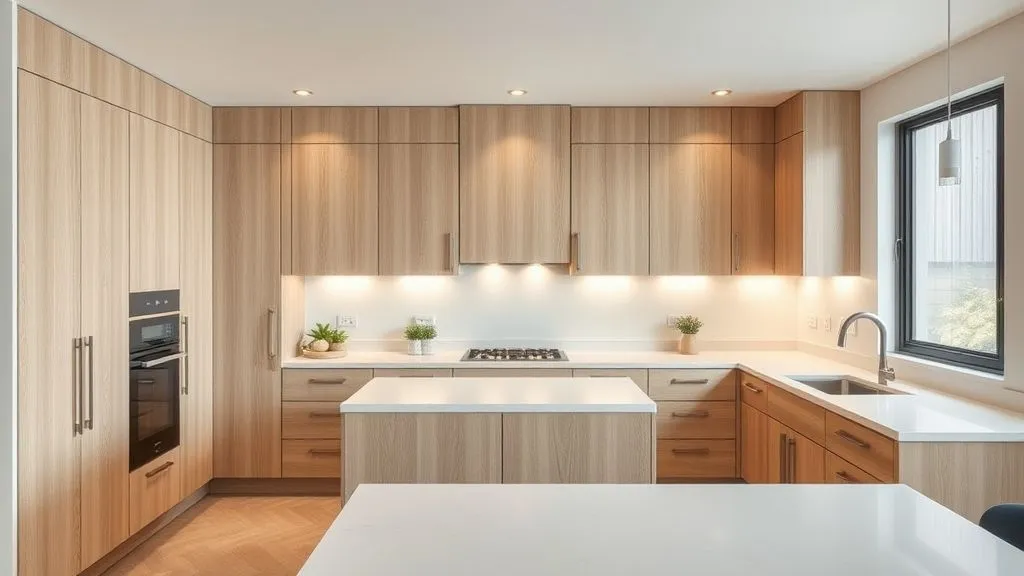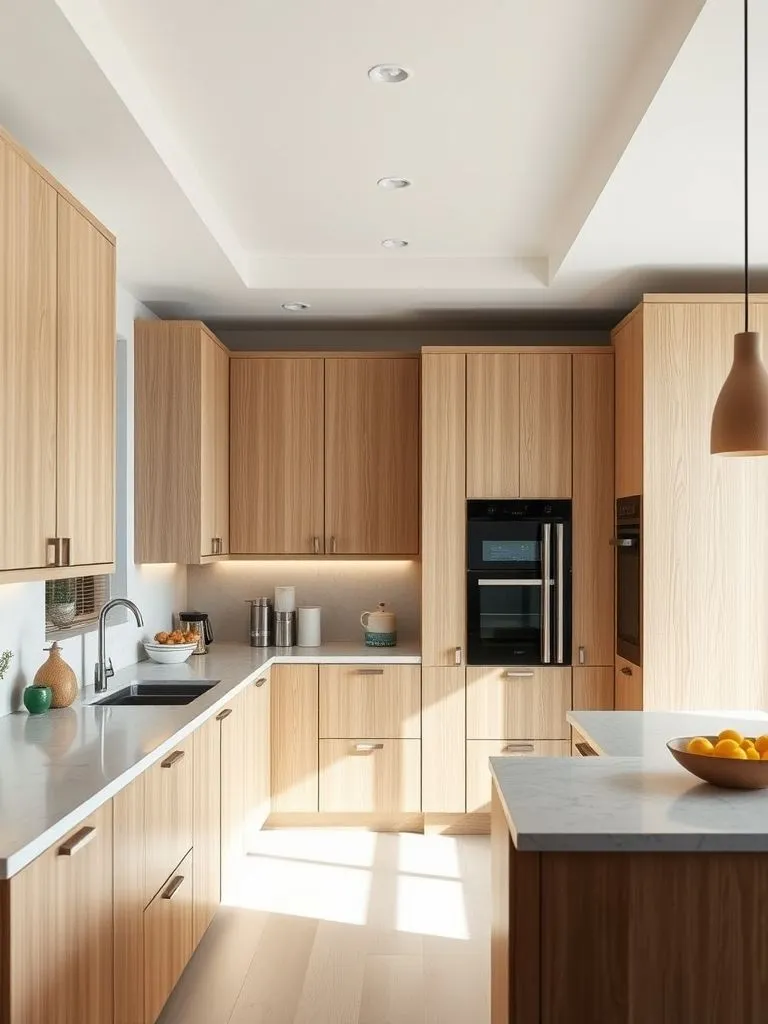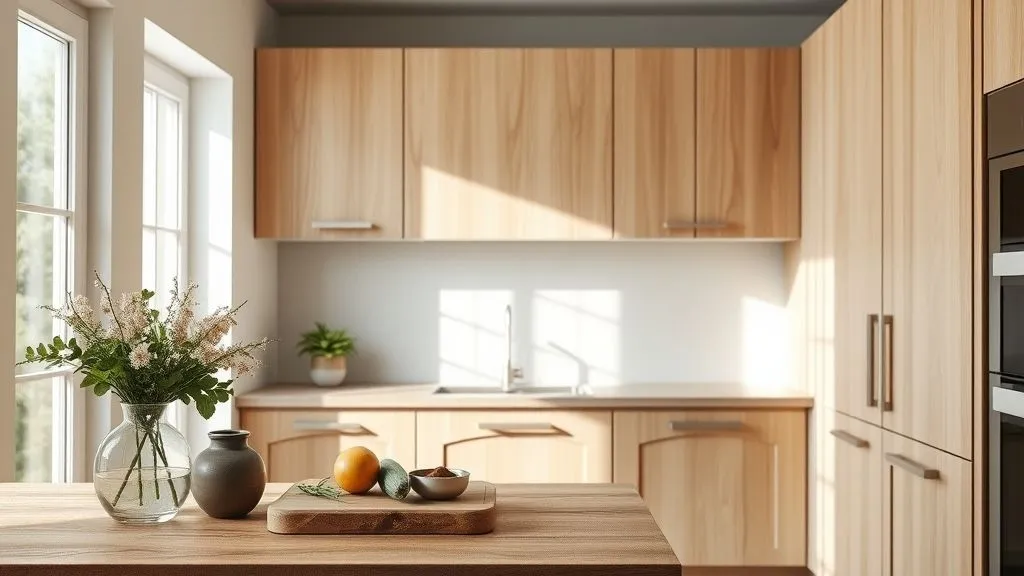Why Choose White Oak Cabinets for Your Kitchen Perfection
When embarking on a kitchen renovation, many homeowners instinctively shy away from oak cabinets, haunted by memories of the honey oak that dominated the 1980s and 90s. However, a quiet revolution is taking place in kitchen design, urging a second look at this classic material. White oak cabinets are stepping into the spotlight as a refined choice that effortlessly blends timeless warmth with modern sophistication. Far from the dated associations of their golden-toned predecessors, white oak cabinets offer a fresh, versatile aesthetic that is captivating designers and homeowners alike. If oak has been off your radar for a modern kitchen, white oak might just change your mind.
Table of Contents
Why Add White Oak to Your Kitchen?
White oak cabinets are gaining traction for reasons that extend well beyond fleeting design trends. Their unique combination of durability, aesthetic appeal, and adaptability makes them a standout choice for any kitchen renovation. Let’s delve into the compelling reasons why white oak deserves a place in your home.
Unmatched Durability
Kitchens are the heart of the home, often enduring heavy use and occasional mishaps. White oak rises to the challenge with a Janka hardness rating of 1360, making it exceptionally resistant to dents, scratches, and wear. This natural resilience ensures that white oak cabinets can withstand the rigors of daily life whether it’s the clatter of pots and pans, enthusiastic cooking sessions, or the inevitable door slams from energetic kids. Unlike softer woods or painted surfaces that quickly show signs of damage, white oak maintains its pristine appearance over time. For busy households or passionate home cooks, this durability translates into a long-lasting investment that looks as good in a decade as it does on day one.
Stunning Grain Patterns
The evolution of oak cabinetry has been transformative, particularly with the shift away from the busy, cathedral grain patterns of yesteryear. Modern white oak cabinets often utilize quarter-sawn or rift-cut milling techniques, which reveal straight, linear grain patterns adorned with captivating ray flecks. These cutting methods highlight the wood’s natural beauty while delivering a cleaner, more sophisticated look compared to traditional flat-cut oak. The result is cabinetry that exudes understated elegance, drawing the eye without overwhelming the space. This refined aesthetic aligns seamlessly with contemporary design preferences, offering the warmth of natural wood with a modern edge.
Trend-Oriented Color Schemes

White oak’s natural palette ranging from warm wheat to subtle green-brown hues perfectly complements today’s preference for neutral, nature-inspired interiors. Unlike red oak, which carries pronounced pinkish undertones, white oak offers a more subdued and versatile foundation. This neutral base makes it an ideal canvas for creating dynamic kitchen designs. White oak pairs effortlessly with a variety of countertop materials, backsplash tiles, and hardware finishes, allowing for endless customization. Additionally, white oak accepts stains beautifully, enabling homeowners to tailor the wood’s tone while preserving its distinctive grain. Whether you prefer a light, airy finish or a deeper, richer hue, white oak adapts to your vision with ease.
Remarkable Versatility
White oak’s greatest strength lies in its ability to transcend design boundaries. For those considering white painted cabinets, white oak offers a compelling alternative, delivering similar brightness with added warmth and texture. It shines in a range of aesthetics, from modern farmhouse and Scandinavian-inspired spaces to mid-century modern and transitional kitchens that blend traditional and contemporary elements. White oak cabinets pair beautifully with bold contrasts, such as dark soapstone countertops, vibrant blue backsplashes, or mixed-material islands. The wood’s inherent warmth softens sleek, modern designs, creating kitchens that feel both cutting-edge and inviting.
How to Incorporate White Oak
To unlock the full potential of white oak cabinets, thoughtful design choices are essential. Here’s how to integrate white oak into your kitchen for a cohesive and stunning result.
Commit to Your Style
A successful kitchen design harmonizes with the architectural style of the home, and white oak’s versatility makes it a perfect fit for nearly any aesthetic. In traditional homes, opt for white oak cabinets with classic door styles paired with sleek, contemporary hardware for a balanced look. For modern spaces, flat-panel doors with minimal or no hardware allow the wood’s natural beauty to take center stage. Farmhouse kitchens benefit from white oak’s warmth when paired with apron-front sinks and vintage-inspired bin pulls. The key is to let white oak enhance your home’s existing style, creating a seamless connection between the kitchen and the rest of the space.
Choose North American White Oak
Not all white oak is created equal, and sourcing matters. North American white oak, particularly from the Appalachian region, is renowned for its consistent color, strength, and exceptional grain patterns. The stable growing conditions in these areas produce timber that ensures uniformity and longevity in your cabinetry. While imported white oak may come with a lower price tag, it often falls short in quality and durability. Given that kitchen cabinets are a significant investment, choosing premium North American white oak guarantees lasting beauty and value for generations.
Incorporate Contrasting Elements
The secret to a dynamic white oak kitchen lies in thoughtful contrast. Unlike the monochromatic oak kitchens of the past, modern designs use complementary materials to add depth and visual interest. Consider pairing white oak cabinets with:
- White marble or quartz countertops for a crisp, luminous contrast that brightens the space.
- Matte black hardware to create a striking pop against the wood’s warm tones.
- Brushed brass light fixtures that amplify the wood’s natural warmth and add a touch of elegance.
- Two-tone designs, such as painted islands or lower cabinets in complementary hues, for a bold yet balanced look.
- Dramatic backsplashes, like patterned tiles or rich colors, that draw attention without clashing with the cabinetry.
These contrasting elements elevate the kitchen’s design, ensuring it feels multidimensional while showcasing the natural allure of white oak.
Maximizing Longevity and Maintenance
To keep white oak cabinets looking their best, proper care is essential. While white oak is naturally durable, regular maintenance preserves its beauty. Dust cabinets weekly with a soft, dry cloth to prevent buildup, and clean spills immediately with a damp cloth followed by a dry one to avoid water marks. For deeper cleaning, use a mild soap solution, avoiding harsh chemicals that could damage the finish. Applying a high-quality furniture polish every six months can enhance the wood’s luster and protect its surface.
Additionally, consider the finish of your white oak cabinets. A matte or low-sheen finish hides minor scratches and wear better than high-gloss options, making it ideal for busy kitchens. If you opt for a stained finish, choose a penetrating oil-based stain for durability and ease of touch-up over time. Sealing the cabinets with a polyurethane or lacquer topcoat adds an extra layer of protection against moisture and wear.
Cost Considerations
White oak cabinets are a premium choice, and costs can vary based on factors like sourcing, milling techniques, and customization. On average, expect to pay $100 to $150 per linear foot for high-quality white oak cabinetry, with quarter-sawn or rift-cut options on the higher end due to their labor-intensive milling process. While this is comparable to other hardwoods like maple or cherry, white oak’s durability and timeless appeal make it a worthwhile investment. For budget-conscious homeowners, semi-custom cabinets or combining white oak with less expensive materials (like painted lower cabinets) can achieve a high-end look at a lower cost.
Environmental Benefits

Sustainability is a growing concern for homeowners, and white oak offers an eco-friendly option. North American white oak is often harvested from responsibly managed forests certified by organizations like the Forest Stewardship Council (FSC). Its durability also means fewer replacements over time, reducing waste. When paired with low-VOC finishes and adhesives, white oak cabinets contribute to a healthier indoor environment and a smaller ecological footprint.
Conclusion
White oak cabinets are more than a design trend they’re a timeless choice that marries durability, beauty, and versatility. Their ability to adapt to diverse styles, withstand the demands of busy kitchens, and elevate spaces with natural elegance makes them a standout option for any renovation. By thoughtfully incorporating contrasting elements, choosing high-quality North American timber, and committing to your home’s unique style, you can create a kitchen that’s both functional and breathtaking. Whether you’re dreaming of a sleek modern space or a cozy farmhouse retreat, white oak cabinets offer the perfect foundation for kitchen perfection.
Looking to explore another stunning wood option? Check out Spalted Maple: 5 Amazing Facts You Need to Know.

